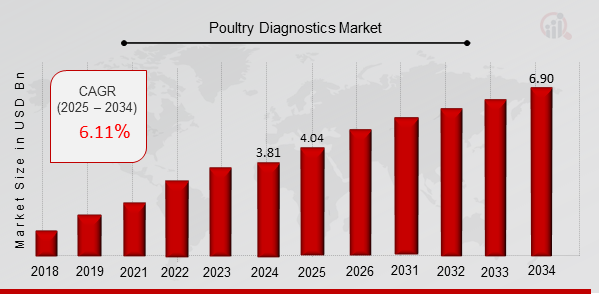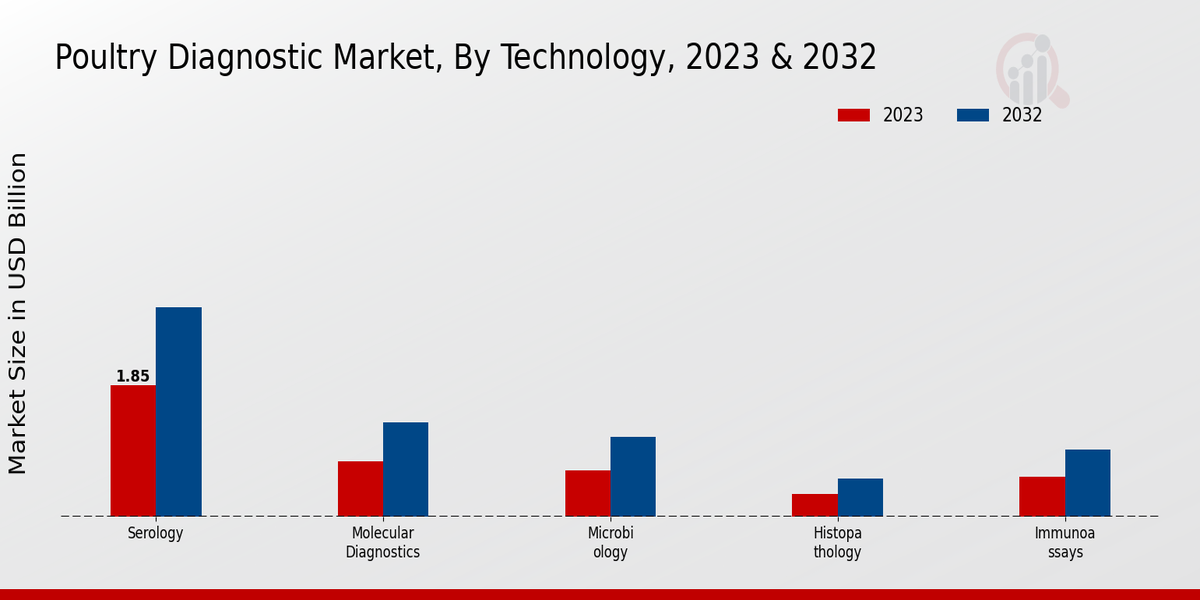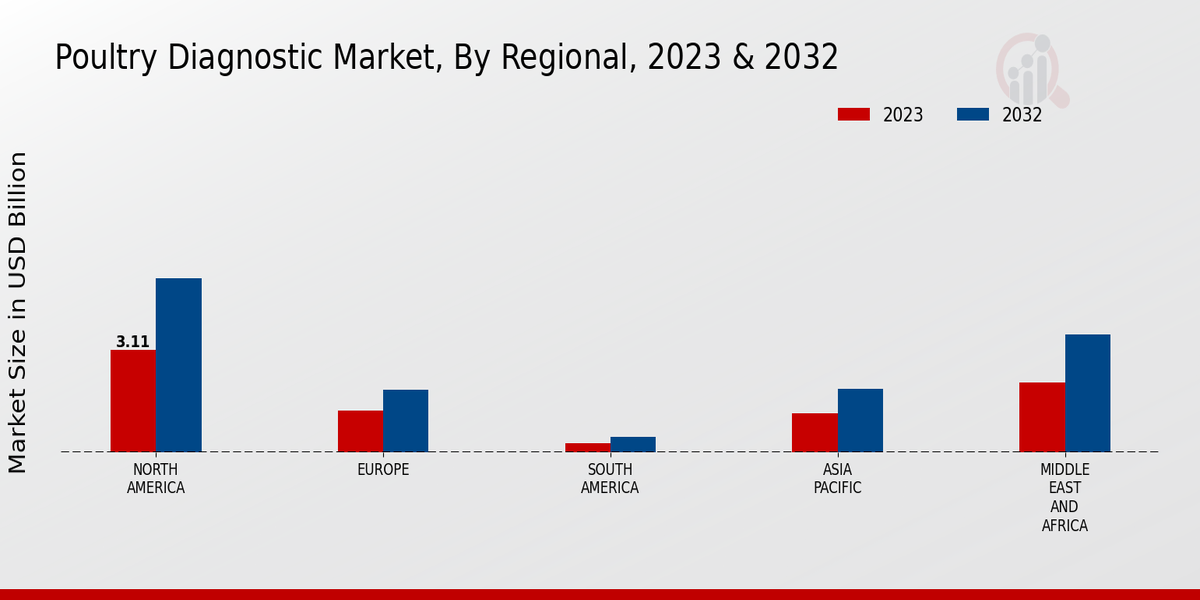Poultry Diagnostics Market Overview
As per MRFR analysis, the Poultry Diagnostics Market Size was estimated at 3.81 (USD Billion) in 2024. The Poultry Diagnostics Market Industry is expected to grow from 4.04 (USD Billion) in 2025 to 6.90 (USD Billion) till 2034, at a CAGR (growth rate) is expected to be around 6.11% during the forecast period (2025 - 2034).
Key Poultry Diagnostics Market Trends Highlighted
Accelerated demand for poultry products coupled with rising concerns over poultry diseases fuels the growth of the Poultry Diagnostics Market. Innovations in diagnostics technologies and increasing adoption of preventive healthcare to combat disease outbreaks create lucrative opportunities for industry players.
Key market trends include the growing adoption of molecular diagnostics, advancements in biosensors and microfluidics, and the emergence of multiplex assays. These advancements enhance diagnostics accuracy, reduce turnaround time, and enable early disease detection. Additionally, the expansion of the poultry industry in developing countries presents untapped opportunities for market expansion.
Recent trends indicate a surge in demand for rapid and on-site diagnostics solutions, driven by the need for timely disease management and quick response to disease outbreaks. The integration of artificial intelligence and machine learning into diagnostics platforms offers promising opportunities to improve diagnostics specificity and sensitivity. Moreover, the focus on precision poultry farming practices emphasizes the importance of accurate diagnostics to ensure optimal animal health and productivity.
 Source Primary Research, Secondary Research, MRFR Database and Analyst Review
Source Primary Research, Secondary Research, MRFR Database and Analyst Review
Poultry Diagnostics Market Drivers
Increasing Prevalence of Poultry Diseases
The rising incidence of poultry diseases is a major factor driving the growth of the poultry diagnostics market. Various factors contribute to this increase, including the intensification of poultry production, the emergence of new and evolving pathogens, and the trade of poultry products. These diseases can cause significant economic losses to the poultry industry, leading to increased demand for diagnostics tests for early detection and control.The poultry diagnostics market offers a comprehensive range of diagnostics tests to identify and characterize poultry diseases, enabling timely and effective interventions to minimize their impact.
Technological Advancements in Diagnostics
The Poultry Diagnostics Market Industry is witnessing rapid advancements in diagnostics technologies, which is another significant driver of market growth. These advancements include the development of molecular diagnostics, such as PCR and real-time PCR, which provide highly accurate and sensitive detection of pathogens. Additionally, automation and miniaturization of diagnostics platforms have enhanced efficiency and reduced turnaround times.The integration of artificial intelligence and machine learning in poultry diagnostics is further revolutionizing the field, enabling faster and more precise analysis of diagnostics data.
Growing Demand for Food Safety and Quality
Consumers are increasingly demanding safe and high-quality poultry products, which has led to stricter regulatory standards and increased emphasis on food safety. Poultry diagnostics tests play a crucial role in ensuring the safety of poultry products by detecting pathogens that can cause foodborne illnesses. The market offers a range of diagnostics tests to screen poultry flocks for various diseases and monitor the quality of poultry products throughout the supply chain.By providing accurate and reliable diagnostics information, the poultry diagnostics market contributes to maintaining public health and consumer confidence in poultry products.
Poultry Diagnostics Market Segment Insights
Poultry Diagnostics Market Technology Insights
The Poultry Diagnostics Market is segmented by technology into serology, molecular diagnostics, microbiology, histopathology, immunoassays, sample preparation, and handheld devices. Serology is expected to hold the largest market share in 2023, owing to its wide applications in disease diagnosis. The market growth is attributed to the rising demand for poultry products, increasing awareness of poultry diseases, and technological advancements in diagnostics techniques. Serology is a cost-effective and widely used technique for detecting antibodies in the blood.It is used to diagnose various poultry diseases, including avian influenza, Newcastle disease, and infectious bronchitis. Molecular diagnostics involves the use of molecular techniques, such as PCR and real-time PCR, to detect the presence of specific pathogens. It offers high sensitivity and specificity and is increasingly used for the rapid and accurate diagnosis of poultry diseases. Microbiology is used to identify and characterize bacteria and fungi that cause poultry diseases.
It involves culturing and isolating microorganisms from samples and performing various tests to determine their identity and antimicrobial susceptibility.Histopathology involves the examination of tissues under a microscope to identify disease-specific changes. It is used to diagnose poultry diseases that cause tissue damage, such as Marek's disease and lymphoid leukosis. Immunoassays utilize antibodies to detect specific antigens in samples. They are used to diagnose various poultry diseases, including avian influenza, Newcastle disease, and infectious bronchitis. Sample preparation plays a crucial role in poultry diagnostics. Proper sample collection and preparation are essential to ensure accurate results.Various techniques are used for sample preparation, including homogenization, extraction, and purification. Handheld devices are becoming increasingly popular in poultry diagnostics. They offer portability, ease of use, and rapid results. Handheld devices are used for various diagnostics tests, including serology,
molecular diagnostics, and immunoassays.
 Source Primary Research, Secondary Research, MRFR Database and Analyst Review
Source Primary Research, Secondary Research, MRFR Database and Analyst Review
Poultry Diagnostics Market Poultry Type Insights
The Poultry Type segment of the Poultry Diagnostics Market is segmented into Chickens, Ducks, Geese, Turkeys, and Other Poultry. Chickens held the largest market share in 2023, accounting for approximately 60% of the market revenue. The large population of chickens and their susceptibility to various diseases drive the demand for diagnostics in this segment. Ducks accounted for the second-largest share, followed by turkeys and geese. Other Poultry, including quail, pigeons, and ostriches, is expected to witness significant growth during the forecast period due to increasing consumption and farming of these birds.
The rising prevalence of poultry diseases, advancements in diagnostics technologies, and growing awareness among poultry farmers are key factors contributing to the growth of the Poultry Diagnostics Market. The segment is expected to continue growing in the coming years, driven by increasing poultry production and the need for effective disease management.
Poultry Diagnostics Market Disease Type Insights
The Poultry Diagnostics Market is segmented by disease type into infectious diseases, non-infectious diseases, metabolic diseases, and reproductive diseases. Among these segments, infectious diseases accounted for the largest market share in 2023, and this trend is expected to continue during the forecast period. The high prevalence of infectious diseases in poultry, such as avian influenza, Newcastle disease, and infectious bronchitis, is driving the growth of this segment. Non-infectious diseases, such as Marek's disease and lymphoid leukosis, are also significant contributors to the market.
Metabolic diseases, such as fatty liver hemorrhagic syndrome and gout, are becoming increasingly common due to changes in poultry diets and management practices. Reproductive diseases, such as egg drop syndrome and infectious bursal disease, can also have a significant impact on poultry production.
Poultry Diagnostics Market End User Insights
The Poultry Diagnostics Market is segmented by end user into commercial poultry farms, diagnostics laboratories, veterinary hospitals and clinics, and research institutes. The commercial poultry farms segment is expected to account for the largest share of the market in 2023, owing to the growing demand for poultry products and the need for accurate and timely diagnosis of poultry diseases. The diagnostics laboratories segment is expected to grow at the highest CAGR during the forecast period, due to the increasing number of poultry diagnostics tests being performed.
The veterinary hospitals and clinics segment is expected to account for a significant share of the market, as veterinarians play a crucial role in diagnosing and treating poultry diseases. The research institutes segment is expected to grow at a steady pace, driven by the increasing focus on poultry research and development.
Poultry Diagnostics Market Regional Insights
The Poultry Diagnostics Market is segmented into North America, Europe, APAC, South America, and MEA. Among these regions, North America is expected to hold the largest market share in 2023, owing to the presence of well-established poultry farming practices, stringent regulatory policies, and advanced diagnostics technologies. Europe is anticipated to follow North America, driven by the increasing demand for poultry products and the growing awareness of poultry diseases. APAC is expected to witness significant growth over the forecast period due to the rising consumption of poultry meat and the increasing prevalence of poultry diseases in the region.South America and MEA are projected to experience moderate growth, driven by the growing poultry industry and the increasing adoption of advanced diagnostics technologies.
 Source Primary Research, Secondary Research, MRFR Database and Analyst Review
Source Primary Research, Secondary Research, MRFR Database and Analyst Review
Poultry Diagnostics Market Key Players And Competitive Insights
Major players in Poultry Diagnostics Market industry are constantly striving to gain a competitive edge by investing in research and development, expanding their product portfolios, and acquiring smaller players. Leading Poultry Diagnostics Market players are focusing on developing innovative diagnostics technologies, such as multiplex PCR and next-generation sequencing, to improve the accuracy and speed of poultry disease detection. Additionally, companies are collaborating with research institutions and government agencies to conduct clinical trials and obtain regulatory approvals for their products. The Poultry Diagnostics Market is characterized by intense competition, with established players and emerging companies vying for market share.IDEXX Laboratories is a leading provider of veterinary diagnostics, including poultry diagnostics. The company offers a wide range of diagnostics tests for poultry diseases, including avian influenza, Newcastle disease, and Marek's disease. IDEXX Laboratories has a strong presence in both developed and emerging markets, and it continues to invest in research and development to maintain its competitive edge. The company's commitment to innovation and customer service has helped it establish a strong reputation in the poultry diagnostics industry.Merial, a subsidiary of Boehringer Ingelheim, is another major player in the Poultry Diagnostics Market. Merial offers a comprehensive range of poultry diagnostics products, including vaccines, diagnostics tests, and antimicrobials. The company has a strong focus on developing innovative diagnostics solutions for poultry diseases, and it invests heavily in research and development. Merial's presence and extensive product portfolio have made it a preferred partner for poultry producers worldwide.
Key Companies in the Poultry Diagnostics Market Include
- Thermo Fisher Scientific Inc.
- Zoetis Inc.
- IDEXX Laboratories, Inc.
- Merial (part of Boehringer Ingelheim)
- Agilent Technologies, Inc.
- Neogen Corporation
- Biovet S.A.
- BioRad Laboratories, Inc.
- Ceva Santé Animale
- Sysmex Corporation
- Heska Corporation
- Qiagen N.V.
- Becton, Dickinson and Company
- Randox Laboratories Ltd.
- DiaSys Diagnostics Systems GmbH
Poultry Diagnostics Market Industry Developments
The poultry diagnostics market is projected to reach USD 5.77 billion by 2032, exhibiting a CAGR of 6.11% during the forecast period (2025-2034). Increasing incidences of poultry diseases, growing demand for poultry products, and technological advancements in diagnostics techniques drive market growth.Recent developments include In 2023, IDEXX Laboratories launched the AI-powered Poultry Vision, an automated poultry health monitoring system. In 2022, Thermo Fisher Scientific acquired Mesa Biotech, expanding its poultry diagnostics portfolio.Key market players include Zoetis IDEXX Laboratories Thermo Fisher Scientific Neogen Corporation Biovet
Poultry Diagnostics Market Segmentation Insights
Poultry Diagnostics Market Technology Outlook
- Serology
- Molecular Diagnostics
- Microbiology
- Histopathology
- Immunoassays
- Molecular Diagnostics
- Sample Preparation
- Handheld Devices
Poultry Diagnostics Market Poultry Type Outlook
- Chickens
- Ducks
- Geese
- Turkeys
- Other Poultry
Poultry Diagnostics Market Disease Type Outlook
- Infectious Diseases
- Non-Infectious Diseases
- Metabolic Diseases
- Reproductive Diseases
Poultry Diagnostics Market End User Outlook
- Commercial Poultry Farms
- Diagnostics Laboratories
- Veterinary Hospitals and Clinics
- Research Institutes
Poultry Diagnostics Market Regional Outlook
- North America
- Europe
- South America
- Asia Pacific
- Middle East and Africa
Poultry Diagnostics Market Report Scope
| Report Attribute/Metric |
Details |
|
Market Size 2024
|
3.81 (USD Billion)
|
|
Market Size 2025
|
4.04 (USD Billion)
|
|
Market Size 2034
|
6.90 (USD Billion)
|
|
Compound Annual Growth Rate (CAGR)
|
6.11 % (2025 - 2034)
|
|
Report Coverage
|
Revenue Forecast, Competitive Landscape, Growth Factors, and Trends
|
|
Base Year
|
2024
|
|
Market Forecast Period
|
2025 - 2034
|
|
Historical Data
|
2020 - 2024
|
| Market Forecast Units |
USD Billion |
| Key Companies Profiled |
Thermo Fisher Scientific Inc., Zoetis Inc., IDEXX Laboratories, Inc., Merial (part of Boehringer Ingelheim), Agilent Technologies, Inc., Neogen Corporation, Biovet S.A., BioRad Laboratories, Inc., Ceva Santé Animale, Sysmex Corporation, Heska Corporation, Qiagen N.V., Becton, Dickinson and Company, Randox Laboratories Ltd., DiaSys Diagnostics Systems GmbH |
| Segments Covered |
Technology, Poultry Type, Disease Type, End User, Regional |
| Key Market Opportunities |
Advanced diagnostics for poultry diseases Smart poultry diagnostics technologies Pointofcare diagnostics tests Nucleic acidbased diagnostics Companion diagnostics |
| Key Market Dynamics |
Increasing poultry consumption rising poultry diseases technological advancements government regulations and strategic collaborations |
| Countries Covered |
North America, Europe, APAC, South America, MEA |
Frequently Asked Questions (FAQ) :
The Poultry Diagnostics Market is expected to reach a valuation of USD 3.38 billion in 2023.
The Poultry Diagnostics Market is projected to grow at a CAGR of 6.11% from 2024 to 2035.
The Poultry Diagnostics Market is expected to reach a valuation of USD 6.90 billion by 2034.
North America is expected to hold the largest market share in the Poultry Diagnostics Market by 2034.
The increasing demand for poultry products, rising awareness of poultry diseases, and technological advancements in diagnostics techniques are key factors driving the growth of the market.
The poultry health segment is expected to hold the largest market share in the Poultry Diagnostics Market by 2032.
Key competitors in the Poultry Diagnostics Market include IDEXX Laboratories, Zoetis, Thermo Fisher Scientific, and Merck.
Challenges faced by the market include the high cost of diagnostics tests, the lack of skilled professionals, and the stringent regulatory environment.
Opportunities for growth include the increasing demand for poultry products, the rising awareness of poultry diseases, and the development of new diagnostics technologies.
Key trends in the market include the adoption of molecular diagnostics, the use of artificial intelligence, and the development of point-of-care tests.

















